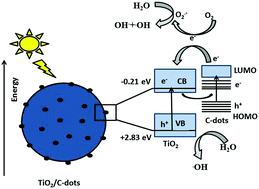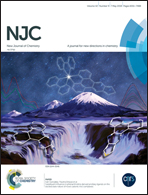Solar light driven photocatalytic degradation of levofloxacin using TiO2/carbon-dot nanocomposites†
Abstract
This paper reports the synthesis of TiO2 quantum dots, carbon dots (C-dots), and TiO2/C-dots using facile sol–gel and hydrothermal methods. The synthesized quantum dots were further characterized in detail to understand their crystalline, structural, morphological, thermal and optical properties using various spectroscopic and analytical techniques. The characterization results confirmed that the prepared photocatalysts exhibited high crystallinity, purity and excellent optical properties. The morphological results indicated that the C-dots were uniformly distributed over the TiO2 quantum dots and nanocomposites have an average size of 12 nm. Furthermore, the prepared sample, i.e. TiO2/C-dots, was efficiently employed as a potential heterogeneous photocatalyst for solar light driven photocatalytic degradation of a fluoroquinolone antibiotic drug levofloxacin. To optimize the photocatalytic degradation experiments, various catalyst dose-dependent, pH-dependent, and initial drug-concentration dependent experiments were carried out. The photocatalytic experiments revealed almost complete photocatalytic degradation of levofloxacin (10 mg L−1) within 90 minutes of solar light illumination using the TiO2/C-dots under optimum conditions, whereas bare TiO2 showed only 66.5% degradation of the drug. Different commercial photocatalysts such as TiO2 PC-50 and TiO2 PC-500 were also used for comparing the photocatalytic efficiency of the synthesized photocatalyst. Furthermore, the stability of the photocatalyst was studied by performing recyclability experiments up to 5 cycles using the TiO2/C-dots, indicating that the nanocomposites could be reused without any significant loss. The TOC results indicated the simultaneous 53.4% mineralization and photocatalytic degradation of levofloxacin under optimized conditions. The enhanced photocatalytic activity of the nanocomposites was attributed to the presence of the C-dots in the system, which provided more active sites for the drug molecules and also restricted the recombination of charge carriers. The role of active radical species in the photocatalytic degradation of levofloxacin was also investigated. A photocatalytic degradation mechanism and pathway were also proposed.



 Please wait while we load your content...
Please wait while we load your content...